Entreq Audio Konstantin Revelation Cables and Olympus Ten T Ground Boxes by Dave Thomas
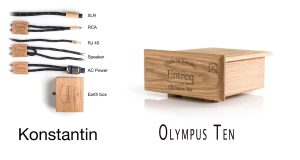
 Some audio designers adopt a mindset about what their products are designed to do, and that mindset permeates their designs throughout their careers. Having had some Entreq cables in my system through most of the last fifteen years, it is clear to me that Entreq Designer and CEO Per-Olof Friberg’s mindset is that the quieter and deeper you make the soundstage, the more music you get out of it. Over the years, I’ve learned that nothing quiets a soundstage like a properly grounded system. Going back to the first set of Entreq cables I reviewed, which were the original Konstantin cables in 2009, Per-Olof has continued to be mindful of the effects of grounding on cables and equipment. As his cable designs evolved, he discontinued the Konstantins and focused on more up-market offerings like his Revelation line of cables. But that move was met with concern from Konstantin fans, prompting Per-Olof to keep them in his lineup. But that presented him with a problem: the Konstantins were still popular and had become close competition for the more expensive Revelations. He was also ready to introduce some new digital cables to the marketplace. What to do? Ladies and gentlemen, I give you the Entreq Konstantin Revelations.
Some audio designers adopt a mindset about what their products are designed to do, and that mindset permeates their designs throughout their careers. Having had some Entreq cables in my system through most of the last fifteen years, it is clear to me that Entreq Designer and CEO Per-Olof Friberg’s mindset is that the quieter and deeper you make the soundstage, the more music you get out of it. Over the years, I’ve learned that nothing quiets a soundstage like a properly grounded system. Going back to the first set of Entreq cables I reviewed, which were the original Konstantin cables in 2009, Per-Olof has continued to be mindful of the effects of grounding on cables and equipment. As his cable designs evolved, he discontinued the Konstantins and focused on more up-market offerings like his Revelation line of cables. But that move was met with concern from Konstantin fans, prompting Per-Olof to keep them in his lineup. But that presented him with a problem: the Konstantins were still popular and had become close competition for the more expensive Revelations. He was also ready to introduce some new digital cables to the marketplace. What to do? Ladies and gentlemen, I give you the Entreq Konstantin Revelations.
I was all in when Per-Olof reached out to tell me that he had overhauled his Konstantin line and added new Ethernet and USB cables. He sent me a full suite of what is now called the Konstantin Revelation cables, along with a couple of other devices that I will get to later in this review. Due to some business travel, I had to work the Entreq cables into my system slowly, not wanting to freak my ears out, which had become so accustomed to the glorious sound of my system wired with the DR Acoustics Classe’ Audio series cables that were a synergistic match with my Classe’ electronics. After nearly two months of swapping and briefly listening, I was finally ready to spend some serious time with my Entreq-connected system.
 I was excited to get into my Entreq connected system and hear what the Konstantin Revelations could do. Forgive me if you’ve heard this story before, but about fifteen years ago, I was listening to a pair of big solid-state mono amps I had borrowed from a friend and had every intention of buying. They were connected to a pair of Escalante Design Fremont loudspeakers. But after weeks of trying, I could not get rid of an audible hum that prevented me from enjoying them. The next day, I stopped by a local audio store and told one of the proprietors about my problem. He walked away and, five minutes later, returned with one of those cable filters and instructed me to connect it between my cable TV wire and my cable box. I did just as he instructed, and, poof, the hum was gone. Sadly, the amps were scheduled to be picked up the next day, and my chance to buy the amps was gone. But I did learn a valuable lesson in the importance of grounding. I called the audio shop and asked the guy what the filter did. He said something to the effect that it lifted the ground and took it out of the music signal. Frankly, I still don’t completely understand what that meant, but I do know that a system or components in a system can be harmful to the sound if not well grounded.
I was excited to get into my Entreq connected system and hear what the Konstantin Revelations could do. Forgive me if you’ve heard this story before, but about fifteen years ago, I was listening to a pair of big solid-state mono amps I had borrowed from a friend and had every intention of buying. They were connected to a pair of Escalante Design Fremont loudspeakers. But after weeks of trying, I could not get rid of an audible hum that prevented me from enjoying them. The next day, I stopped by a local audio store and told one of the proprietors about my problem. He walked away and, five minutes later, returned with one of those cable filters and instructed me to connect it between my cable TV wire and my cable box. I did just as he instructed, and, poof, the hum was gone. Sadly, the amps were scheduled to be picked up the next day, and my chance to buy the amps was gone. But I did learn a valuable lesson in the importance of grounding. I called the audio shop and asked the guy what the filter did. He said something to the effect that it lifted the ground and took it out of the music signal. Frankly, I still don’t completely understand what that meant, but I do know that a system or components in a system can be harmful to the sound if not well grounded.
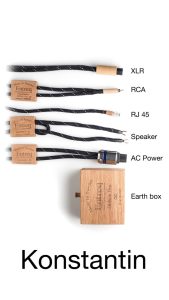
Getting back to the Konstantin Revelations, physically, they have maintained their organic good looks. The Entreq cables are sheathed in a black cotton fabric. Inside the fabric are separate cable runs for positive(+) and negative(-) signals to eliminate magnetic fields. The cables also use what Entreq calls Dedicated Integrated Contacts (DIC) to keep the signal path as straight and clear as possible. Wood is used in the contact framework because of its non-magnetic and non-conductive properties. The cables also use pure copper and/or silver in the signal paths and feature a drain wire instead of shielding to connect to a pure earth point, called an External Earth Drain System (EEDS).
 During an exchange of emails with Per-Olof, I learned that the Konstantin Revelation cables use the same materials and conductors as the original Konstantins, the main difference being the amount of burn-in time required to get optimal sound. Per-Olof says the cables sound okay during the first 10-20 hours. Then they sound a little worse until you reach around 80-100 hours. But after 100 hours, they slowly get better and better, and after 250 hours, they sound downright good. At 400 hours, they sound great, and after 600-800, they are fantastic. The configuration of the conductors also plays a significant role in the sound. Even though the original Konstantins and the new cables use the same materials, they are used differently. The result in both cases is an eminently musical sound that draws you into your recordings…, after you get through the considerable burn-in period.
During an exchange of emails with Per-Olof, I learned that the Konstantin Revelation cables use the same materials and conductors as the original Konstantins, the main difference being the amount of burn-in time required to get optimal sound. Per-Olof says the cables sound okay during the first 10-20 hours. Then they sound a little worse until you reach around 80-100 hours. But after 100 hours, they slowly get better and better, and after 250 hours, they sound downright good. At 400 hours, they sound great, and after 600-800, they are fantastic. The configuration of the conductors also plays a significant role in the sound. Even though the original Konstantins and the new cables use the same materials, they are used differently. The result in both cases is an eminently musical sound that draws you into your recordings…, after you get through the considerable burn-in period.
My listening experience with the Konstantin Revelations was similar to previous experiences with products from this company. That is a credit to their consistency and never-ending pursuit of providing deeper and quieter soundstages from which your system can pull out everything in your music.
Most of my listening sessions were done using two sources:
- My router connected to the Bricasti M5 Network Player using Entreq’s new Ethernet cable. The M5 was connected to the Delta PRE’s AES (XLR) digital input.
- The Classe CDT-300 Transport is connected to one of the Delta PRE’s coaxial inputs. I then ran XLR cables from the Delta PRE to my Delta MONOs.
- I ran speaker cables from the amps to my Tekton Double Impact SEs.
The Entreq cables replaced some of my reference cables, the Classe’ Delta Series cables from DR Acoustics. Going in, I knew the Entreq cables would be hard-pressed to sound better than cables designed with my electronics in mind, but the experience was quite interesting. I quickly learned that comparing these two would not be a matter of whether one was better. Instead, both sets of cables had distinctly different yet very appealing sounds. It was almost a tube versus solid-state comparison. The DR Acoustics cables are highly detailed, articulate, and fabulous at rendering instruments and large venues. The Entreqs, on the other hand, have more of a lively presentation, especially in the way they render female vocals.
 A great example is the song “You Make Me Wanna” from the Becca Stevens Band’s CD, Perfect Animal [UMG Recordings]. Stevens is one of my favorite singers, and she frequently shows up and is featured on recordings by artists such as pianist Taylor Eigsti and Gretchen Parlato. She does a fabulous job of sliding between musical genres and is just as at home with folk songs as she is with jazz and R&B. Another area in which the two are very diverse is live music. “Easy Money” by Lars Danielsson & Leszek Mozdzer from the album iTunes Live: Berlin Festival [Apple Music]. The DR Acoustics cables do a wonderful job of capturing the size of the venue. There is a video of this performance on YouTube, and you can hear the music coming from a space the size shown in the video. The Entreq cables, focusing on rendering darker and quieter soundstages to gain more music and better-defined imaging, produce that very thing in this recording. These are both wonderfully made and sounding products, so I won’t bother declaring a winner here.
A great example is the song “You Make Me Wanna” from the Becca Stevens Band’s CD, Perfect Animal [UMG Recordings]. Stevens is one of my favorite singers, and she frequently shows up and is featured on recordings by artists such as pianist Taylor Eigsti and Gretchen Parlato. She does a fabulous job of sliding between musical genres and is just as at home with folk songs as she is with jazz and R&B. Another area in which the two are very diverse is live music. “Easy Money” by Lars Danielsson & Leszek Mozdzer from the album iTunes Live: Berlin Festival [Apple Music]. The DR Acoustics cables do a wonderful job of capturing the size of the venue. There is a video of this performance on YouTube, and you can hear the music coming from a space the size shown in the video. The Entreq cables, focusing on rendering darker and quieter soundstages to gain more music and better-defined imaging, produce that very thing in this recording. These are both wonderfully made and sounding products, so I won’t bother declaring a winner here.
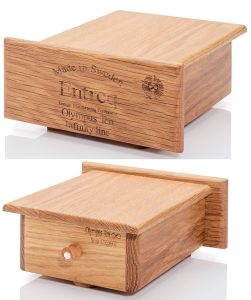
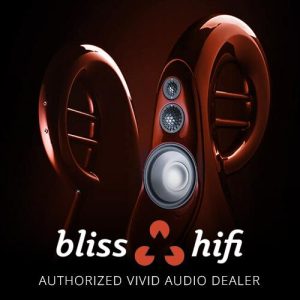 Now, I’d like to discuss something Per-Olof sent me after I received the cables for this review, and that’s a couple of Entreq Olympus Ten T (Tungsten) ground boxes. As I mentioned earlier, Entreq is dedicated to what I believe are deeper and quieter soundstages, but not just from the design of its cables. They have created a full suite of ground boxes that take quiet stereo performance to a new level. The Olympus Ten T ground boxes are designed for equipment with low power consumption, such as switches, routers, streamers, or anything that works well with DACs and preamps with smaller power supplies. They can also be used to ground the negative poles of amplifiers on the speaker output terminals. Frankly, I had read a lot of message board material online, downplaying these boxes’ benefits and creation. Some people feel that many of these boxes are grossly overpriced and have even gone to the extent of creating their homemade boxes by filling a wooden box with a combination of minerals, metals, and other stuff. Well, frankly, the same can probably be said of most things in audiophile systems. All audiophiles have friends who ran to Radio Shack, bought a bunch of wire and terminations, and created their home-brewed speaker cables and interconnect. But since I’m not a DIY guy, I’ll leave that to the designers and engineers who can do it better.
Now, I’d like to discuss something Per-Olof sent me after I received the cables for this review, and that’s a couple of Entreq Olympus Ten T (Tungsten) ground boxes. As I mentioned earlier, Entreq is dedicated to what I believe are deeper and quieter soundstages, but not just from the design of its cables. They have created a full suite of ground boxes that take quiet stereo performance to a new level. The Olympus Ten T ground boxes are designed for equipment with low power consumption, such as switches, routers, streamers, or anything that works well with DACs and preamps with smaller power supplies. They can also be used to ground the negative poles of amplifiers on the speaker output terminals. Frankly, I had read a lot of message board material online, downplaying these boxes’ benefits and creation. Some people feel that many of these boxes are grossly overpriced and have even gone to the extent of creating their homemade boxes by filling a wooden box with a combination of minerals, metals, and other stuff. Well, frankly, the same can probably be said of most things in audiophile systems. All audiophiles have friends who ran to Radio Shack, bought a bunch of wire and terminations, and created their home-brewed speaker cables and interconnect. But since I’m not a DIY guy, I’ll leave that to the designers and engineers who can do it better.
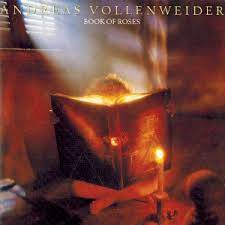 Besides, what the Olympus Ten T did for my system is hard to put into words and was certainly not something I could have done. When I added them to my Classe’ Delta MONOs, they added solidity to the performance of my system, which meant deeper, better-defined bass and well-delineated instrument placement. Swiss harpist Andreas Vollenweider’s epic CD, Book of Roses [Columbia], was brilliantly portrayed with added depth and weight when I added the Olympus Ten Ts. One of my favorite tracks from this sixteen-track disc is “Passage to Promise,” which features the magnificent voices of Ladysmith Black Mambazo. I saw a live performance of this entire album nearly three decades ago, and I remember the joy with which Ladysmith sings. That joy comes through fabulously due to the depth of the soundstage. I remembered that the singers stood right at the front of the stage, just like they did during the listening sessions in my house.
Besides, what the Olympus Ten T did for my system is hard to put into words and was certainly not something I could have done. When I added them to my Classe’ Delta MONOs, they added solidity to the performance of my system, which meant deeper, better-defined bass and well-delineated instrument placement. Swiss harpist Andreas Vollenweider’s epic CD, Book of Roses [Columbia], was brilliantly portrayed with added depth and weight when I added the Olympus Ten Ts. One of my favorite tracks from this sixteen-track disc is “Passage to Promise,” which features the magnificent voices of Ladysmith Black Mambazo. I saw a live performance of this entire album nearly three decades ago, and I remember the joy with which Ladysmith sings. That joy comes through fabulously due to the depth of the soundstage. I remembered that the singers stood right at the front of the stage, just like they did during the listening sessions in my house.
Conclusion
I’m glad that Per-Olof Friberg allowed me to spend time with the Konstantin Revelations and the Olympus Ten Ts. I have always appreciated the innovation of his designs and his commitment to maximizing systems through thoughtful cable design and system grounding. It’s not every day that a cable designer tells you that they are combining the strengths of their most affordable cables with one of the more expensive cables and still keeping them affordable. That is a recipe for success for Entreq. High-end audio can use more of this way of thinking. Highly recommended


Specifications:
Konstantin Revelation
Network Cable 1.1m Silver and Copper: USD 1,500
USB Digital Cable 1.1m Silver and Copper: USD 1,000
Speaker Cables: USD 2,200
Interconnect Cables: USD 1,400
Power Cord: USD 1,500
Olympus Ten T Ground Box: USD 1,450
Entreq Headquarters
Rönnetorp
265 90 S-Åstorp
Sweden
Tel: +46 (0)705 200 500
WhatsApp: +46 (0)705200500
Email: info@entreq.com
Website: www.entreq.com
USA and Canadian Importer:
Wynn Audio
69-315 Village Green Sq.
Scarborough, ON, M1S0L2
Canada
WhatsApp: +1 (647) 833-6888
Email: info@wynnaudio.com
Dave’s Associated Equipment
Analog Front End
Small Audio Manufacture Aldebaran Turntable
Small Audio Manufacture Calista II Tonearm
Air Tight PC7 Phono Cartridge
Digital Front End
Classe’ CDT-300 Transport
Roon Streaming Platform
Apple Music Streaming Service
Amplification
Classe’ Audio Delta PRE
Classe’ Audio Delta Mono
Bricasti M5 Network Player
Loudspeakers
Tekton Double Impact Loudspeakers
Audeze LCD-X Electrostatic Headphones
Cabling
DR Acoustics Classe’ Series Cables
Entreq Audio Apollo Cables
AudioQuest OptiLink optical cable
AudioQuest Forest coaxial digital cable
Accessories
Salamander Design Synergy Model 345 AV Cabinet
Isoclean 60A3 II Power Conditioner
Entreq Vibbeaters
Entreq AC Wraps
Stereo Times Masthead
Publisher/Founder
Clement Perry
Editor
Dave Thomas
Senior Editors
Frank Alles, Mike Girardi, Russell Lichter, Terry London, Moreno Mitchell, Paul Szabady, Bill Wells, Mike Wright, and Stephen Yan,
Current Contributors
David Abramson, Tim Barrall, Dave Allison, Ron Cook, Lewis Dardick, John Hoffman, Dan Secula, Don Shaulis, Greg Simmons, Eric Teh, Greg Voth, Richard Willie, Ed Van Winkle, Rob Dockery, Richard Doran, and Daveed Turek
Site Management Clement Perry
Ad Designer: Martin Perry






Be the first to comment on: Entreq Audio Konstantin Revelation Cables and Olympus Ten T Ground Boxes by Dave Thomas